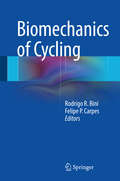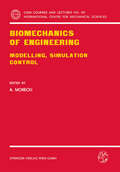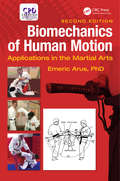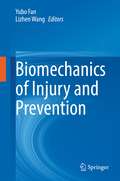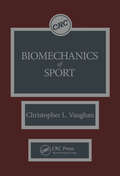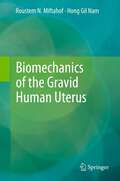- Table View
- List View
Biomechanics of Cells and Tissues: Experiments, Models and Simulations (Lecture Notes in Computational Vision and Biomechanics)
by Paola LeccaThe application of methodological approaches and mathematical formalisms proper to Physics and Engineering to investigate and describe biological processes and design biological structures has led to the development of many disciplines in the context of computational biology and biotechnology. The best known applicative domain is tissue engineering and its branches. Recent domains of interest are in the field of biophysics, e.g.: multiscale mechanics of biological membranes and films and filaments; multiscale mechanics of adhesion; biomolecular motors and force generation. Modern hypotheses, models, and tools are currently emerging and resulting from the convergence of the methods and phylosophycal apporaches of the different research areas and disciplines. All these emerging approaches share the purpose of disentangling the complexity of organisms, tissues, and cells and mimiking the function of living systems.The contributions presented in this book are current research highlights of six challenging and representative applicative domains of phyisical, engineering, and computational approaches in medicine and biology, i.e tissue engineering, modelling of molecular structures, cell mechanics and cell adhesión processes, cancer physics, and physico-chemical processes of metabolic interactions. Each chapter presents a compendium or a review of the original results achieved by authors in the last years. Furthermore, the book also wants to pinpoint the questions that are still open and that could propel the future research.
Biomechanics of Cycling
by Rodrigo R. Bini Felipe P. CarpesBicycles have been a common device to enhance physical fitness level in gyms and training centers along with solid use in competitive sport. For that reason, biomechanics of cycling has grown as a research field with many publications addressing different perspective of the interaction between the cyclist and his bicycle. The most common end point of research on biomechanics of cycling is optimization of performance and reduction of injury risk. One goal of this book is to meet the growing need for a comprehensive presentation of contemporary knowledge on biomechanics of cycling which will positively influence the activity of cycling in a global fashion. In order to accomplish this purpose, ten chapters are presented with focus on varying methods for biomechanical analysis of cycling motion. The introduction section provides an overview of the main methods for assessment of cycling motion, including motion analysis, pedal force measurements, muscle activation, anthropometry and joint kinetics. These methods are discussed in depth in individual chapters followed by chapters on characteristics of bicycles and potential perspectives to improve their configuration in order to improve performance of cyclists and reduce their overuse injury risk. Moreover, a preliminary method to train technique in cyclists is shown. A final chapter provides authors perspective on the upcoming technology that should be effective in helping training of cyclists.
Biomechanics of Diarthrodial Joints: Volume I
by Van C. Mow Anthony Ratcliffe Savio L-Y. WooHistorical folklore indicates that Asklepios (circa 900 BC), the fir~t western doctor of ancient Greece, treated many patients with rheumatic diseases of 1 joints ,2. Later, Hippocrates (circa 400 BC), who claimed to have learned from Asklepios, used the term arthritis in reference to joint diseases: "When the disease of arthritis strikes, acute inflammation and pain attacks the joints of the body ... ". Indeed, arthritic joint disease dates much farther back into antiquity than Asklepios. Many modern anthropologists have noted degenerative joint disease in the fossils of Neanderthal man (archanthropus europeus petraloniensis) and even in those of dinosaurs. More recent scientific studies on joints date back to the work of the great English anatomist Hunter who wrote "The Structure and Diseases of Articular Cartilage" in the Philosophical Transactions of London in 1743. The notion that osteoarthritis results from the wearing away of cartilage was copiously documented by the histological observations of the German physician Ecker in 1843. This idea was further supported by Pommer (1927) who felt that mechanical stresses played important roles in the initiation and propagation of cartilage lesions leading to osteoarthritis. This same conclusion was reached by the assembled distinguished experts at a National Institutes of Health Workshop 3 held in 1986 .
Biomechanics of Engineering: Modelling, Simulation, Control (CISM International Centre for Mechanical Sciences #291)
by Adam MoreckiBiomechanics of Human Motion: Applications in the Martial Arts, Second Edition
by Emeric Arus, Ph.D.This book covers the general laws governing human biomechanics through an extensive review of martial arts techniques and references to fundamental theory. Using straightforward mathematics and physics, this work covers indepth the anatomical foundation of biomechanics and physiological foundation of human motion through specific and relevant martial arts applications. This book also covers the kinematics and kinetics of biomechanics via examples from martial arts and their comparison to different sports techniques. It is written to be used and referenced by biomechanical professionals and martial arts enthusiasts.
Biomechanics of Human Motion: Applications in the Martial Arts, Second Edition
by Emeric Arus, Ph.D.This book covers the general laws governing human biomechanics through an extensive review of martial arts techniques and references to fundamental theory. Using straightforward mathematics and physics, this work covers indepth the anatomical foundation of biomechanics and physiological foundation of human motion through specific and relevant martial arts applications. This book also covers the kinematics and kinetics of biomechanics via examples from martial arts and their comparison to different sports techniques. It is written to be used and referenced by biomechanical professionals and martial arts enthusiasts.
Biomechanics of Human Motion: Basics and Beyond for the Health Professions
by Barney LeVeauBiomechanics of Human Motion: Basics and Beyond for the Health Professions presents a straightforward approach to the basic principles, theories and applications of biomechanics and provides numerous techniques and examples for approaching biomechanical situations enhanced by healthcare professionals.Building on his previous work, Dr. Barney LeVeau uses clearly defined, concise terms and real-life applications rather than advanced mathematics to make teaching and learning biomechanics easier. Based upon the concept of force, the text illustrates how force is applied to the human body and how the body applies force to various objects. The emphasis is upon the pertinent factors that guide the reader to an understanding of biomechanics at a beginning level.Chapter Topics Include:• Strength of material such as loading and stress-strain relationships• Composition and Resolution of Forces such as graphic method and mathematical method• Equilibrium such as static, first condition and second condition• Dynamics such as kinematics and kinetics • Application such as stability and balance, motion analysis, and gaitWhat’s Inside:• Simple explanations of biological & mechanical concepts• Contemporary articles at the end of each chapter providing readers with information beyond the basics• Over 240 images illustrate biomechanical situations and computations• User-friendly, uncomplicated mathematical formulas and examplesBiomechanics of Human Motion: Basics and Beyond for the Health Professions provides students and clinicians of all allied health professions with a basic background and solid foundation on which to build a solid understanding of force and biomechanics.
Biomechanics of Human Motion: Basics and Beyond for the Health Professions
by Barney LeVeauBiomechanics of Human Motion: Basics and Beyond for the Health Professions presents a straightforward approach to the basic principles, theories and applications of biomechanics and provides numerous techniques and examples for approaching biomechanical situations enhanced by healthcare professionals.Building on his previous work, Dr. Barney LeVeau uses clearly defined, concise terms and real-life applications rather than advanced mathematics to make teaching and learning biomechanics easier. Based upon the concept of force, the text illustrates how force is applied to the human body and how the body applies force to various objects. The emphasis is upon the pertinent factors that guide the reader to an understanding of biomechanics at a beginning level.Chapter Topics Include:• Strength of material such as loading and stress-strain relationships• Composition and Resolution of Forces such as graphic method and mathematical method• Equilibrium such as static, first condition and second condition• Dynamics such as kinematics and kinetics • Application such as stability and balance, motion analysis, and gaitWhat’s Inside:• Simple explanations of biological & mechanical concepts• Contemporary articles at the end of each chapter providing readers with information beyond the basics• Over 240 images illustrate biomechanical situations and computations• User-friendly, uncomplicated mathematical formulas and examplesBiomechanics of Human Motion: Basics and Beyond for the Health Professions provides students and clinicians of all allied health professions with a basic background and solid foundation on which to build a solid understanding of force and biomechanics.
The Biomechanics of Impact Injury: Biomechanical Response, Mechanisms of Injury, Human Tolerance and Simulation
by Albert I. KingThis text acquaints the reader on the biomechanics of injury to the human body caused by impact and the use of computer models to simulate impact events. It provides a basic understanding of the biomechanics of the injuries resulting from the impact to the head, neck, chest, abdomen, spine, pelvis and the lower extremities, including the foot and ankle. Other topics include side impact, car-pedestrian impact, effectiveness of automotive restraint systems and sports-related injuries. Featuring problems and PowerPoint slides for lectures, the volume is ideal for students in graduate programs in biomechanics, as well as practicing engineers, and researchers in the life sciences concerned with orthopedics.
Biomechanics of Injury and Prevention
by Yubo Fan Lizhen WangThis book summarizes the recent advancements for biomechanics of injury and prevention in mechanism, application and developing frontiers. Biomechanics plays an important role in achieving safety, health, comfort, and a high quality of life by revealing injury mechanism and providing prevention methods. The book covers injury and prevention to the entire human body, from head to toe, including injury and prevention in sports, traffic, accident, clinic and so on. In addition, bionics prevention method inspired by woodpecker is also introduced. The book provides the reader with not only the mechanism of injury but also the advanced injury diagnosis, treatment, and prevention devices based on biomechanics.
Biomechanics of Lower Limb Prosthetics
by Mark R. PitkinForeword from a Clinical Biomechanist, Applied Physiologist and Prosthetist teaching graduate students in Prosthetics & Orthotics. While there are many books on Biomechanics, arguably the quintessential science of limb prosthetics, none addresses the fundamental principles in sufficient detail and depth to be practically useful to the prosthetist, rehabilitation specialist or researcher. Dr. Pitkin’s monograph is an exemplary collection of theoretical principles from his research and o- ers, presented in its clinical and applied biomechanics form. The textbook provides an excellent overview of the many facets of lower limb prosthetic design and engineering for the ardent clinician researcher and student. The book delves into many of the basic concepts that are required knowledge for the clinician and the scientist to have as the foundation for their work. Dr. Pitkin has an e- quent manner in which he reflects on the history and literature to tell the storied evolution of prosthetic design . He takes the reader on a journey to consider his theories, which have substantive foundations to contemplate. By the end of chapter one, we have the basic h- tory and an appreciation for the rationale behind the “rolling joint ankle” with evidence to support his theoretical views.
Biomechanics of Normal and Pathological Human Articulating Joints (NATO Science Series E: #93)
by Ali E. Engin Kelo M. Correia da SilvaThe widespread occurrence of the various forms of arthritis not only results in a great waste of manpower, but also causes immeasurable pain and suffering for the patients. Due to the limited understanding of its etiology, the currently available treatments are directed at the effects of the disease rather than its causes. The solutions available to the clinician at the advanced stages of arthritis are frequently surgical and include prosthetic replacement arthroplasty. Many advances have been made in the last decade in the basic understanding of the kinematics and kinetics of anatomical joints, as well as in the technology of joint replacement. The NATO Advanced Study Institute held in Portugal during June 20-July 1, 1983 addressed these topics and provided instruction on the advances in biomechanics of diarthrodial joints. The proceedings of this Institute are presented in this volume. Many different areas of specialization contribute to the field of joint biomechanics. Due to the complexity of each individual topic, it was not attempted here to present a complete treatise of each of these areas. Each chapter typically gives a review and a flavor of the subject matter, as well as discussing the state-of the-art advances in general or in specific research areas. Some of the chapters, such as those on lubrication and muscle mechanics, are more mathematically oriented than the others. Nevertheless, the reader with a non-engineering background, I trust, would still find most of the book informative and easy to read.
Biomechanics of Soft Tissue in Cardiovascular Systems (CISM International Centre for Mechanical Sciences #441)
by Gerhard A. Holzapfel Ray W. OgdenThe book is written by leading experts in the field presenting an up-to-date view of the subject matter in a didactically sound manner. It presents a review of the current knowledge of the behaviour of soft tissues in the cardiovascular system under mechanical loads, and the importance of constitutive laws in understanding the underlying mechanics is highlighted. Cells are also described together with arteries, tendons and ligaments, heart, and other biological tissues of current research interest in biomechanics. This includes experimental, continuum mechanical and computational perspectives, with the emphasis on nonlinear behaviour, and the simulation of mechanical procedures such as balloon angioplasty.
Biomechanics of Soft Tissues: Principles and Applications
by Adil Al MayahThe emerging paradigm of incorporating images and biomechanical properties of soft tissues has proven to be an integral part of the advancement of several medical applications, including image guided radiotherapy and surgery, brachytherapy, and diagnostics. This expansion has resulted in a growing community of medical, science, and engineering professionals applying mechanical principles to address medical concerns. This book is tailored to cover a range of mechanical principles, properties, and applications of soft tissues that have previously been addressed in various journals and "anatomical site-specific" books. Biomechanics of Soft Tissues follows a different approach by offering a simplified overview of widely used mechanical models and measuring techniques of soft tissue parameters. This is followed by an investigation of different medical applications, including: biomechanical aspects of cancerous tumor progressions, radiotherapy treatment, and image guided ultrasound guided interventions. Written by leading scholars and professionals in the field, Biomechanics of Soft Tissues combines engineering and medical expertise, thereby producing an excellent source of information for professionals interested in the theoretical and technological advancements related to soft tissues. The book provides medical professionals with an insight on various modeling approaches, testing techniques, and mechanical characteristics that are frequently used by engineers. Conversely, the presented medical applications provide engineers with a glimpse of amazing medical practices and encourage them to expand their roles in the medical field. Provides a simplified overview of mechanics of soft tissues. Highlights different techniques to measure tissues properties for engineering and medical applications. Contains novel ideas to address roles of mechanics in disease progression and treatment. Presents innovative applications of biomechanics in medical procedures.
Biomechanics of Soft Tissues: Principles and Applications
by Adil Al MayahThe emerging paradigm of incorporating images and biomechanical properties of soft tissues has proven to be an integral part of the advancement of several medical applications, including image guided radiotherapy and surgery, brachytherapy, and diagnostics. This expansion has resulted in a growing community of medical, science, and engineering professionals applying mechanical principles to address medical concerns. This book is tailored to cover a range of mechanical principles, properties, and applications of soft tissues that have previously been addressed in various journals and "anatomical site-specific" books. Biomechanics of Soft Tissues follows a different approach by offering a simplified overview of widely used mechanical models and measuring techniques of soft tissue parameters. This is followed by an investigation of different medical applications, including: biomechanical aspects of cancerous tumor progressions, radiotherapy treatment, and image guided ultrasound guided interventions. Written by leading scholars and professionals in the field, Biomechanics of Soft Tissues combines engineering and medical expertise, thereby producing an excellent source of information for professionals interested in the theoretical and technological advancements related to soft tissues. The book provides medical professionals with an insight on various modeling approaches, testing techniques, and mechanical characteristics that are frequently used by engineers. Conversely, the presented medical applications provide engineers with a glimpse of amazing medical practices and encourage them to expand their roles in the medical field. Provides a simplified overview of mechanics of soft tissues. Highlights different techniques to measure tissues properties for engineering and medical applications. Contains novel ideas to address roles of mechanics in disease progression and treatment. Presents innovative applications of biomechanics in medical procedures.
Biomechanics of Sport
by Christopher L. VaughanThis informative text features current and thorough reviews of the biomechanics of sport for improved performance, etiology, and pre-vention of injuries. Winter sports and aquatics are covered, with an emphasis on developing training programs for ski-jumping, alpine, and cross country skiing. Other sports featured include modeling perspectives in speed skating, swimming, and the mechanics of rowing and sculling. Track-and-field athletics, ball games, weight lifting, and training are examined in terms of per-formance, safety, and re-search methodology. Sports scientists and sports medicine specialists will find this book invaluable.
Biomechanics of Sport
by Christopher L. VaughanThis informative text features current and thorough reviews of the biomechanics of sport for improved performance, etiology, and pre-vention of injuries. Winter sports and aquatics are covered, with an emphasis on developing training programs for ski-jumping, alpine, and cross country skiing. Other sports featured include modeling perspectives in speed skating, swimming, and the mechanics of rowing and sculling. Track-and-field athletics, ball games, weight lifting, and training are examined in terms of per-formance, safety, and re-search methodology. Sports scientists and sports medicine specialists will find this book invaluable.
Biomechanics of the Brain (Biological and Medical Physics, Biomedical Engineering)
by Karol MillerBiomechanics of the Brain will present an introduction to brain anatomy for engineers and scientists. Experimental techniques such as brain imaging and brain tissue mechanical property measurement will be discussed, as well as computational methods for neuroimage analysis and modeling of brain deformations due to impacts and neurosurgical interventions. Brain trauma between the different sexes will be analyzed. Applications will include prevention and diagnosis of traumatic injuries, such as shaken baby syndrome, neurosurgical simulation and neurosurgical guidance, as well as brain structural disease modeling for diagnosis and prognosis.This book will be the first book on brain biomechanics. It will provide a comprehensive source of information on this important field for students, researchers, and medical professionals in the fields of computer-aided neurosurgery, head injury, and basic biomechanics.
Biomechanics of the Brain (Biological and Medical Physics, Biomedical Engineering)
by Karol MillerThis new edition presents an authoritative account of the current state of brain biomechanics research for engineers, scientists and medical professionals. Since the first edition in 2011, this topic has unquestionably entered into the mainstream of biomechanical research. The book brings together leading scientists in the diverse fields of anatomy, neuroimaging, image-guided neurosurgery, brain injury, solid and fluid mechanics, mathematical modelling and computer simulation to paint an inclusive picture of the rapidly evolving field.Covering topics from brain anatomy and imaging to sophisticated methods of modeling brain injury and neurosurgery (including the most recent applications of biomechanics to treat epilepsy), to the cutting edge methods in analyzing cerebrospinal fluid and blood flow, this book is the comprehensive reference in the field. Experienced researchers as well as students will find this book useful.
Biomechanics of the Gastrointestinal Tract: New Perspectives in Motility Research and Diagnostics
by Hans GregersenBiomechanics of the Gastrointestinal Tract is an up-to-date book for researchers on the study of the mechanical properties and the motor system of the gastrointestinal tract. A well-illustrated book, it provides a comprehensive overview to relevant tissue geometry, morphology and biomechanical theory. Separate chapters cover smooth muscle and nerve function including the application to animal and human studies of motility, symptoms and pain, determination of the true resting state, history-dependent properties, and tissue remodelling in disease. Several methods and diagnostic applications such as determination of in vivo length-tension diagrams and multimodal pain testing are completely new but will undoubtedly be used by many in the future. New non-invasive imaging techniques based on ultrasound, MR- and CT-scanning in combination with balloon distension are emerging as the techniques for future in vivo studies.
Biomechanics of the Gravid Human Uterus
by Roustem N. Miftahof Hong Gil NamThe complexity of human uterine function and regulation is one of the great wonders of nature and represents a daunting challenge to unravel. This book is dedicated to the biomechanical modeling of the gravid human uterus and gives an example of the application of the mechanics of solids and the theory of soft shells to explore medical problems of labor and delivery. After a brief overview of the anatomy, physiology and biomechanics of the uterus, the authors focus mainly on electromechanical wave processes, their origin, dynamics, and neuroendocrine and pharmacological modulations. In the last chapter applications, pitfalls and problems related to modeling and computer simulations of the pregnant uterus and pelvic floor structures are discussed. A collection of exercises is added at the end of each chapter to help readers with self-evaluation.The book serves as an invaluable source of information for researchers, instructors and advanced undergraduate and graduate students interested in systems biology, applied mathematics and biomedical engineering.
Biomechanics of the Hip: As Applied to Osteoarthritis and Related Conditions
by P.G.J. MaquetDr. MAQUET, the foremost disciple of Professor PAUWELS' and the orthopae dic heir to the PAUWELS' concepts of osteotomy of the hip for arthritis, has assembled in this one book the strongest and most lucid contemporary statement of the principles and practice of this very important school of hip surgery. Professor PAUWELS' contributions to the understanding of the biomechanics of the hip and to the concepts and execution of osteotomy of the hip for arthritis are outstanding and timeless. With clarity, Dr. MAQUET articulates this position and refines it further in the light of his own investiga tion. While other investigators, of course, differ on individual concepts or princi ples in this book or disagree with specific positions, assumptions, or conclu sions, it is clear to all that this book is a benchmark work. Dr. MAQUET, as Professor PAUWELS always did, illustrates his text lavishly with beautiful examples of individual cases illuminating the principles ad vanced. But in addition, he has gone further and presents long-term follow-up data, quantifying the results of these surgical precepts as experienced in his own practice. It is a work that has been long sought and is richly received. Boston, Massachusetts, 1984 WILLIAM H. HARRIS, M.D.
Biomechanics of the Human Body (Undergraduate Lecture Notes in Physics)
by Emico Okuno Luciano FratinBiomechanics of the Human Body teaches basic physics concepts using examples and problems based on the human body. The reader will also learn how the laws of mechanics may help to understand the conditions of the static and dynamic equilibrium of one of the marvels of nature: the human body. The mathematical language used in physics has always been pointed out as responsible for students’ difficulties. So, each concept given is followed by explanatory examples, with subsequent application and fixation exercises. It is a richly illustrated book that facilitates the comprehension of presented concepts. Biomechanics of the Human Body can be useful to students of physical and occupational therapy, physical education, the life sciences, and health care professionals who deal with biomechanics. This book is also recommended for sport practitioners as well as the general reader interested in the mechanics of the human body.
Biomechanics of the Human Stomach
by Roustem N. MiftahofThis book concerns the mathematical modeling and computer simulation of the human stomach. It follows the four modern P’s (prevention, prediction, personalization, and precision in medicine) approach in addressing the highly heterogeneous nature of processes underlying gastric motility disorders manifested as gastroparesis, functional dyspepsia, myenteric enteropathy etc. The book comprehensively guides readers through the fundamental theoretical concepts to complex physiological models of the organ. This requires a deep and thorough understanding of driving pathophysiological mechanisms as well as the collaborative effort of specialists working in fundamental and biological science. Such a multidisciplinary partnership is vital because it upholds gnostic capabilities and provides the exchange of thoughts and ideas thus offering broad perspectives into the evolution and management of diseases. The book is a valuable resource for applied mathematicians, computational biologists, bioengineers, physicians, physiologists and researchers working in various fields of biomedicine.
Biomechanics of the Human Urinary Bladder
by Roustem N. Miftahof Hong Gil NamAs a research subject, the biomechanics of the urinary bladder are relatively young, yet medical problems associated with them are as old as mankind. Offering an update on recent achievements in the field, the authors highlight the underlying biological, chemical and physical processes of bladder function and present the systematic development of a mathematical model of the organ as a thin, soft biological shell. The book will be a valuable resource for postgraduate students and researchers interested in the applications of computational mathematics and solid mechanics to modern problems in biomedical engineering and medicine.

